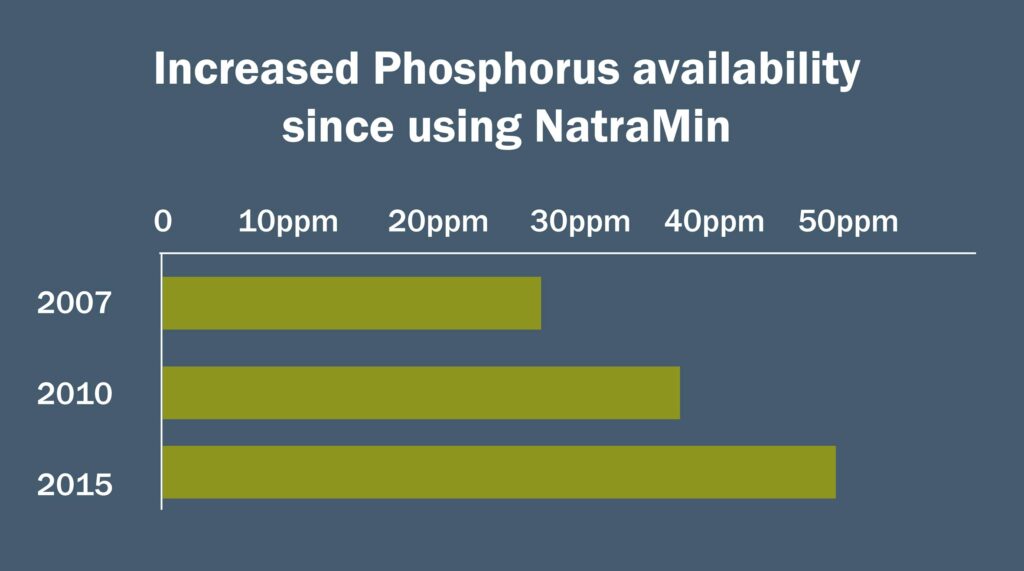Do you have a Phosphate Bank in your soil?
If you have used phosphate fertiliser in the past, then the answer to that question is probably “YES”.
Phosphorus Lock Up
CSIRO Research reported: “It is thought that, at best, just 20 per cent of Phosphorus applied by way of fertiliser is available for plant uptake in the year it is applied. Successive generations of Australian farmers have applied huge quantities of phosphorus fertilizer to combat the problem of chronic phosphorus deficiency in their soil. This has led to a massive bank of fixed phosphorus, estimated at close to $10 billion at current Superphosphate prices. This means, that of the dollars spent applying Superphosphate at a rate of 250kg per hectare (about 22.5kg of P) often just one tenth of this P (2.25kg) is immediately available to plants.” (Source: CSIRO article, Raiding the Phosphate Bank, 1997).
In separate research carried out by Cooperative Research Centre for Soil and Land Management, it was reported that high levels of fertiliser can reduce the effectiveness of soil organisms. For example, high N inputs reduce Nitrogen fixation and high P inputs reduce the beneficial effects of mycorrhizae.
The role of VAM in Phosphate availabity
It is a well known that VAM (mycorrhizae fungi) is essential for the release of phosphorus. In addition to the detrimental effect applied fertiliser can have on the soil microbe population, the use of herbicides can also significantly depress micro-organisms. Drought conditions also contribute to a reduction in VAM, while crops such as mung bean, chickpea and maize perform a valuable role because they contribute to increased levels of VAM.
How big is the Phosphate Bank?
It is thought that each hectare of soil may hold up to 400kg of phosphorus, with less than 4kg immediately available to crops or pasture. (Source: CSIRO article, Raiding the Phosphate Bank 1997). A soil test is designed to only provide an indication of nutrients that are available to a crop. It is possible to have a “total test” carried out, which would show exactly the amount of each element in the soil. While it would provide some benefit to have this information, if phosphate fertiliser has been applied regularly in the past, then it is likely there will be at least some Phosphate locked up in your soil.
The importance of Minerals
Broad spectrum minerals are essential for soil health and fertility. The Fertiliser Industry Handbook states: “Maximum response will not be obtained from an applied Phosphatic fertiliser, whether water-soluble or water-insoluble, unless adequate quantities of other plant nutrients, including the secondary and trace elements, are present.”
Why make the change to NatraMin?
Over many decades of farming, mineral elements have become depleted from the soil and many Australian farmers understand the problems associated with declining soil ferility… having to use increasing levels of high analysis fertiliser, crop protectants and tillage to maintain and improve production. Remineralisation with NatraMin is now recognized as a core part of the solution. Our range of NatraMin Mineral Fertilisers and Soil Conditioners are formulated to provide bio-activated broad spectrum minerals and trace elements… assisting to restore the Nutritional, Biological and Structural aspects of soil fertility:
Nutritional: supply of broad spectrum minerals and trace elements
Biological: stimulation of microbe and worm activity to assist in the conversion of organic matter into humus, helping to neutralise soil pH and increase nutrient availability.
Structural: improvement of soil aggregation assisting to reduce tillage costs, increase moisture holding capacity, improve root development and increase plant growth and yield.
When integrated with soil management strategies such as crop rotation and returning some mulch, NatraMin can assist to produce living, healthy and balanced soil capable of producing high yield crops, pastures and livestock.
Over the years, we have had many graizers who have successfully used NatraMin to replace Superphosphate in their fertiliser program and the most common reports include:
– the strong return of clover and other legumes
– improvement in soil structure and root development, and
– the visible return of earthworms
Tenterfield cattleman, Brian Berridge, applied annual applications of NatraMin to his pastures between 2008 and 2012. Prior to using NatraMin, Brian’s country had an extensive history of Superphosphate but still had low levels of available Phosphorus.
Monitoring with regular soil tests allowed us to track the effectiveness of using NatraMin. Soil pH levels improved and there was an ongoing increase in the availability of most nutrients including Phosphorus, Calcium and Sulphur. Soil tests showed an initial 30ppm Phosophorus prior to using NatraMin, increasing to 40ppm in 2007 and 52ppm in 2015.
Brian reported: “We have been happy with our pastures since applying NatraMin. The country looks good with plenty of strong clover.”

AgSolutions Soil Testing Service
Solutions to nutrition are often simple and they also need to be cost effective and realistic. If you need more Phosphorus we will advise that as a priority, but it is important to remember that if you continue to apply Phosphorus when it is not required, lock-up can increase and other imbalances can occur.
So, take the first step to making a change. If you would like to arrange for a soil test to be performed, or would like a second opinion on an existing soil test, give us a call on 1800 81 57 57.
